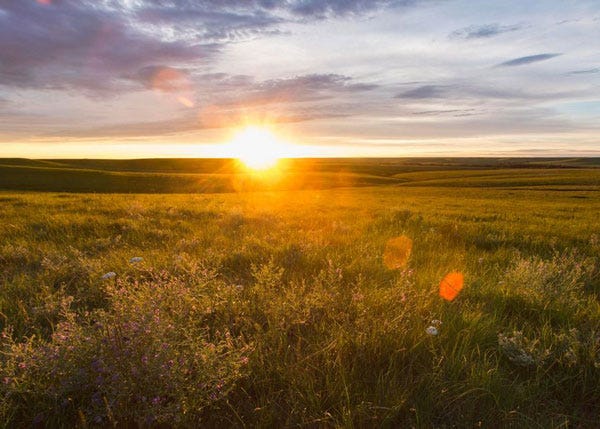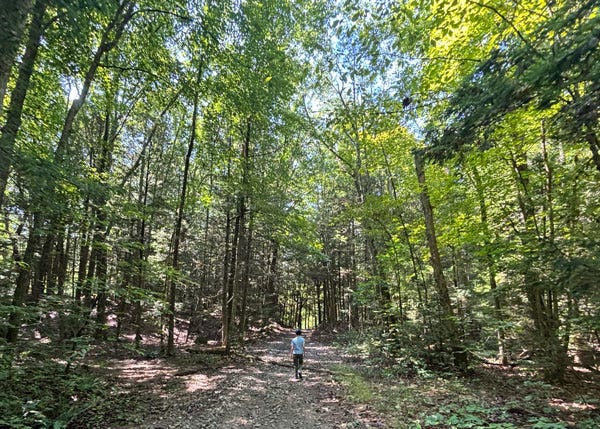Rescue the Rainforest (and Beyond)
Saving the rainforest is important. But so too is conserving what's in our own backyards
Welcome to another edition of Willoughby Hills!
This newsletter explores topics like history, culture, work, urbanism, transportation, travel, agriculture, self-sufficiency, and more.
When I was a kid in the early 1990s, there was a lot of talk about saving the rainforest. The wonders, beauty, and endangerment of the Amazonian rainforest of Brazil seemed firmly in the zeitgeist.
The first Rainforest Cafe opened at the Mall of America in Minnesota in 1994, eventually reaching 45 worldwide outlets at the height of its popularity. The restaurant itself was basically a heightened version of a local TGI Fridays or Applebees, with a dressed up menu of burgers, fries, and chicken fingers. But people didn’t go for the food, they went for the atmosphere.
Each Rainforest Cafe location featured animatronic jungle animals, an aquarium of tropical fish, vinyl vines hung from the ceiling, and an indoor lightning and rain storm that would happen roughly every 20 minutes. The vibe had elements of kitsch combined with a crass commercialism (each location also featured a sizable gift shop). But somehow, there was also an underlying message of conservation.
Beyond the novelty of getting to “experience” the “rainforest” at your local mall and hopefully take some lessons home about preservation, some dining rooms made that instruction more explicit. Some locations featured a giant sculpture of Atlas holding the earth on his shoulders, only this earth was emblazoned with the neon slogan “Rescue the Rainforest.”

Meanwhile, closer to home, in 1992 the Cleveland Metroparks Zoo opened its RainForest exhibit, which at the time resembled a futuristic shopping mall. The all-indoor attraction, which closed last year, featured 600 animals, 7,000 plants, a geodesic dome, and, like the Rainforest Cafe, a simulated rainstorm.

The RainForest became a field trip destination, and I remember visiting because it closely aligning with a rainforest unit we were studying in school at the time.
Captain Planet played on our television sets, a cartoon series very blatantly about conservation. Jungle animals like macaws and toucans were featured on all kinds of consumer products for children, from bright neon Lisa Frank folders to Ty Beanie Babies.

Some of this environmental messaging made sense. The rainforest was being clear cut to make way for cattle ranches and other farming.
But the conservation rhetoric also seemed to involve a vague belief that the rainforest held some kind of magic that we didn’t quite understand in our modern world. Somewhere, deep in the canopies, might be a plant that could cure cancer or provide some other miracle treatment. But we would never know because we were literally “pav[ing] paradise to put up a parking lot” as Amy Grant sang in 1995 (covering Joni Mitchell).
As I’ve grown older, I’ve given a lot of thought to how that early environmental messaging of my childhood has affected me. There was certainly an urgency to the notion of saving the rainforest that seemed to permeate our pop culture, but I wonder why those notions of conservation only applied a continent away and not in our own backyards.
I often lament signs of new development near me- the open acreage of a farm turned into dozens of new houses or trees cleared to make way for yet another CVS or McDonald’s.
But lately, I’ve also been considering the plots of land next door to that former farm or wooded lot. For the last 20 years, or 40 years, or 100 years, these lots that now hold houses, stores, and restaurants have seemed a permanent part of our landscape. We accept their current state as perfectly normal and rational. Of course that house or fast food restaurant is okay, it’s always been there! But it hasn’t. The developed sites of today are the raw sites of yesterday, just as in five years, that lot being clear cut for a McDonald’s will be normalized as the place McDonald’s has been forever.
I often find myself wandering the forests of New England and wondering what makes them different from the Amazonian rainforest. It’s true that the species of both flora and fauna are dissimilar, but we romanticize the tropical rainforest as perhaps containing the cure to cancer, while we overlook our own trees.
This isn’t a new attitude by any means, dating back to the European settlement of North America on this continent. According to the Sierra Club:
“White pines were one of the first species that settlers targeted, reducing stand after stand of them to stumps and slash. Once they had mostly exhausted the white pine supply, they moved on to other tree species. Between the 17th and 20th centuries, European settlers cleared more than 99 percent of the forests in New England and New York, not just once but two or even three times, first for agriculture and timber and then for industry.”
There were once white pines taller than 200 feet in the Northeastern forests. Very few, if any, remain.
We’re planning a road trip in the Midwest this summer, and one of the places that I want to visit is Tallgrass Prairie National Preserve outside of Emporia, KS. According to the National Park Service:
“Tallgrass prairie once covered 170 million acres of North America, but within a generation most of it had been transformed into farms, cities, and towns. Today less than 4% remains intact, mostly in the Kansas Flint Hills. Established on November 12, 1996, the preserve protects a nationally significant remnant of the once vast tallgrass prairie ecosystem. Here the tallgrass makes its last stand.”
This national preserve, a public-private partnership between the National Park Service and the Nature Conservancy is free and accessible 24 hours a day. It features 10,000 acres with more than 40 miles of trails through a native prairie habitat. It even reintroduced a wild bison herd onto the prairie in 2009.

I have driven across the Midwest many times, including some stretches of Kansas, and rolling grasslands full of biodiversity are not what I remember. Mostly, I remember thousands of acres of cornfields, planted by machine in neat rows, sprayed with chemical fertilizer and pesticide, irrigated with giant sprinklers, and harvested by machine.
What’s the difference between these grasslands, home to vast numbers of grasses, wildflowers, insects, and mammals, and the tropical rainforest? Why do we assume that one requires preservation at all cost when another can be tiled over without a second thought? Isn’t a miracle drug just as likely to be in a diverse prairie or a Northeastern pine forest as in a tropical rainforest?
Ultimately, it feels like the rhetoric around what should be saved and what can be destroyed for the sake of “progress” reeks of colonialism. We want to tell Brazilians not to clear cut their native habitat, but we won’t tell Americans to do the same. We eroticize the forests of South America, but view our own backyards as unremarkable, and thus, targets for destruction.
It’s the same conversation that happens in climate change circles when describing the rapid industrialization of countries like China and India, where air conditioning, personal cars, and other comforts now proliferate. Americans wag our fingers to the East, while doing little to curb our own addiction to air conditioning, big houses, and sprawling neighborhoods.
Do as we say, not as we do.
Ultimately, I’m grateful that I was exposed to the conservation movement as a child, even if it was centered in the rainforest and not in our own community. Those early seeds caused me to look at nature differently, to appreciate the symbiosis of the world around us, and to recognize that humans are a part of this vast ecosystem, not separate from it or above it.
I feel like we are overdue for another environmental moment, something that can permeate the consciousness of our time the way the rainforest seemed to dominate culture in the 1990s. I’m not sure what form this latest iteration might take, but if a goofy restaurant themed to white pines or tallgrass prairies can get the kids of today to appreciate something different about their world, I’d be okay with that.
Thanks for reading Willoughby Hills! Subscribe for free to receive new posts and support my work.
Related Reading
Our Chemical Industrial Complex
If you’ve missed past issues of this newsletter, they are available to read here.






My daughter went to the University of Iowa (just graduated) and we live in Texas, so we’ve driven I-35 through Kansas many times over the last five years. The Flint Hills are my favorite part of the drive. Hope you enjoy the visit.